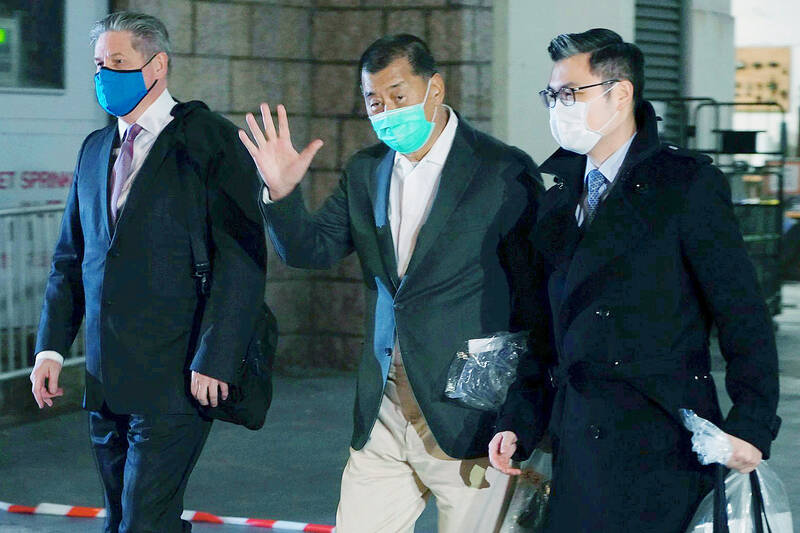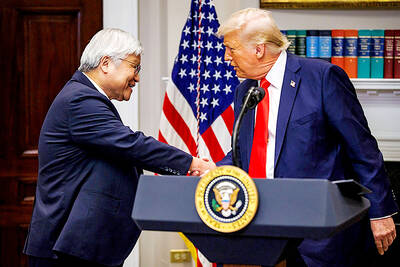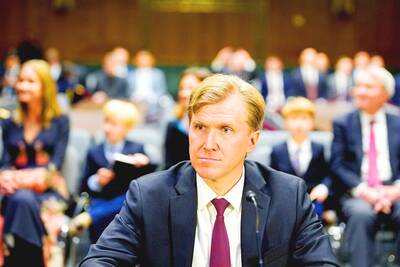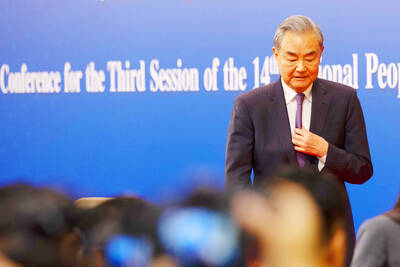More than 100 journalists and editors have signed an open letter calling for the immediate release of media mogul Jimmy Lai (黎智英), who has been detained in Hong Kong on national security charges.
Leading global media figures — including the Guardian editor-in-chief Katharine Viner and Nobel peace prize winner Maria Ressa — called for the charges against Lai and other journalists in Hong Kong to be dropped.
Lai, who is 75 and was first arrested in 2020, is the founder and publisher of the Apple Daily, a liberal newspaper that was forced to close in 2021 after the Chinese Communist Party cracked down on pro-democracy protests.

Photo: AP
A longtime critic of the party, Lai is now one of the most high-profile activists in Hong Kong to have been arrested since the Chinese government imposed a sweeping National Security Law on the territory in 2020.
Lai was charged with contravening the National Security Law in August 2020. His trial for that case is scheduled for September, but since his arrest he has been convicted on separate charges of fraud and organizing illegal protests — charges that his supporters say are politically motivated.
The signatories to the letter, which was organized by Reporters Without Borders (RSF), said: “We, as publishers and editors of news media organisations from around the world, are united in support of Apple Daily founder and publisher Jimmy Lai, and his fight for media pluralism and press freedom in Hong Kong.”
“Jimmy Lai has stood for these values his entire life... In a tremendous act of courage, he chose to stay in Hong Kong and continued to publish as long as he could, despite the severe crackdown taking place around him,” the letter said.
Hong Kong is ranked 140th out of 180 countries in RSF’s 2023 World Press Freedom Index, down from 58th place 10 years ago.
In March, Caoilfhionn Gallagher, Lai’s international lawyer, said the tactics used by Hong Kong’s authorities amounted to “lawfare” — the use of legal mechanisms to suppress opposition — citing the fraud conviction as a tool to smear Lai’s character.
On Thursday, Hong Kong passed a law allowing authorities to ban foreign lawyers from working on national security cases, as a means of preventing Lai from engaging British lawyer Tim Owen in his coming trial.
Lai’s supporters have also criticized the British government for not doing enough to advocate for Lai’s release.
Last week, Sebastian Lai (黎崇恩), the elder Lai’s son, said the British government was “incredibly weak” for failing to call for the release of his father.
A spokesperson for the UK Foreign Office said it had “regularly” brought its concerns to Chinese and Hong Kong authorities, including the foreign secretary raising Lai’s case at the UN Human Rights Council in February.
“We have made clear our strong objection to China’s imposition of the National Security Law in Hong Kong, which is being used in a deliberate attempt to target and silence pro-democracy figures, including Jimmy Lai,” the spokesperson said.

CRITICAL MOVE: TSMC’s plan to invest another US$100 billion in US chipmaking would boost Taiwan’s competitive edge in the global market, the premier said The government would ensure that the most advanced chipmaking technology stays in Taiwan while assisting Taiwan Semiconductor Manufacturing Co (TSMC, 台積電) in investing overseas, the Presidential Office said yesterday. The statement follows a joint announcement by the world’s largest contract chipmaker and US President Donald Trump on Monday that TSMC would invest an additional US$100 billion over the next four years to expand its semiconductor manufacturing operations in the US, which would include construction of three new chip fabrication plants, two advanced packaging facilities, and a research and development center. The government knew about the deal in advance and would assist, Presidential

‘DANGEROUS GAME’: Legislative Yuan budget cuts have already become a point of discussion for Democrats and Republicans in Washington, Elbridge Colby said Taiwan’s fall to China “would be a disaster for American interests” and Taipei must raise defense spending to deter Beijing, US President Donald Trump’s pick to lead Pentagon policy, Elbridge Colby, said on Tuesday during his US Senate confirmation hearing. The nominee for US undersecretary of defense for policy told the Armed Services Committee that Washington needs to motivate Taiwan to avoid a conflict with China and that he is “profoundly disturbed” about its perceived reluctance to raise defense spending closer to 10 percent of GDP. Colby, a China hawk who also served in the Pentagon in Trump’s first team,

SEPARATE: The MAC rebutted Beijing’s claim that Taiwan is China’s province, asserting that UN Resolution 2758 neither mentions Taiwan nor grants the PRC authority over it The “status quo” of democratic Taiwan and autocratic China not belonging to each other has long been recognized by the international community, the Mainland Affairs Council (MAC) said yesterday in its rebuttal of Beijing’s claim that Taiwan can only be represented in the UN as “Taiwan, Province of China.” Chinese Minister of Foreign Affairs Wang Yi (王毅) yesterday at a news conference of the third session at the 14th National People’s Congress said that Taiwan can only be referred to as “Taiwan, Province of China” at the UN. Taiwan is an inseparable part of Chinese territory, which is not only history but

INVESTMENT WATCH: The US activity would not affect the firm’s investment in Taiwan, where 11 production lines would likely be completed this year, C.C. Wei said Investments by Taiwan Semiconductor Manufacturing Co (TSMC, 台積電) in the US should not be a cause for concern, but rather seen as the moment that the company and Taiwan stepped into the global spotlight, President William Lai (賴清德) told a news conference at the Presidential Office in Taipei yesterday alongside TSMC chairman and chief executive officer C.C. Wei (魏哲家). Wei and US President Donald Trump in Washington on Monday announced plans to invest US$100 billion in the US to build three advanced foundries, two packaging plants, and a research and development center, after Trump threatened to slap tariffs on chips made